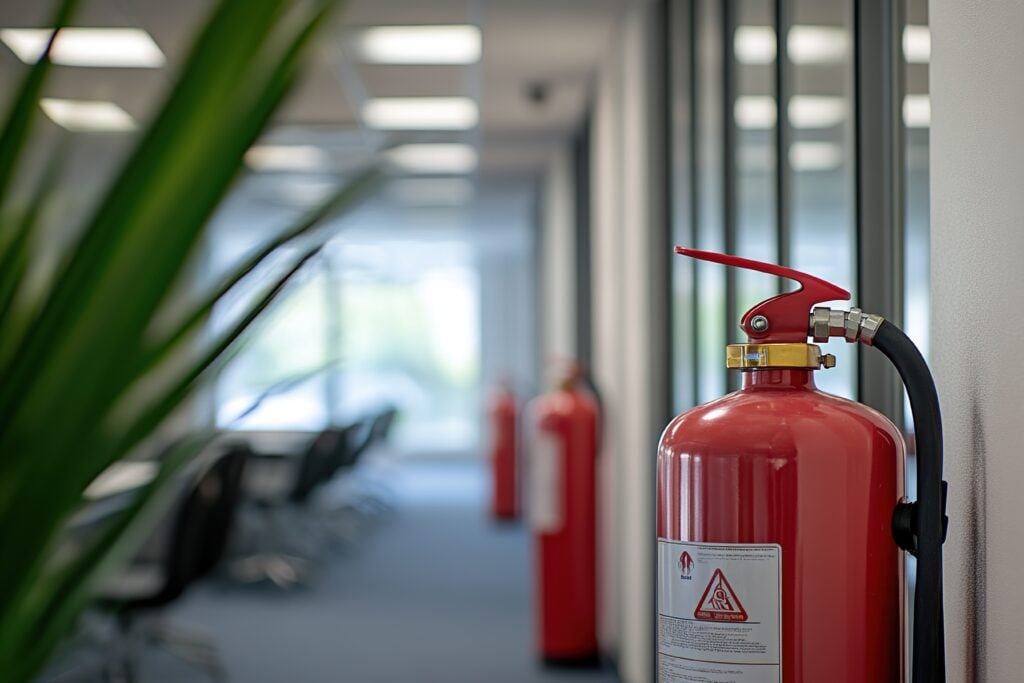So, who lit the microwave on fire again?
Office fires might not come with a Hollywood explosion soundtrack, but they’re no joke. One forgotten coffee pot or overloaded power strip and suddenly, Karen from accounting is evacuating the building without her spreadsheet. The good news? These fiery disasters are super preventable if you know your stuff, and lucky you, you’re about to.
Let’s talk triangles, and no, not the love kind.
Enter: the fire triangle. A drama-free (sorta) three-part system that explains how fire starts. All it takes is:
- Fuel: Anything flammable, paper, cardboard, your motivational sticky notes.
- Oxygen: Yep, that breathable thing keeping us all alive. Fire loves it too.
- Heat: Enough to ignite the fuel. Think faulty outlets or that rebellious space heater.
Remove one of those elements, and poof, fire drama canceled.
Not all fires are created equal, so meet the five fiery divas.
- Class A: Basic combustibles. Paper, wood, office plants that are definitely dead.
- Class B: Flammable liquids and gases. Yes, that air freshener counts.
- Class C: Electrical fires. When wires get wild.
- Class D: Combustible metals, rare in offices but worth knowing.
- Class K: Cooking oils. A regular in office breakroom disasters.
Pro tip: most offices use multi-purpose ABC fire extinguishers. They’re the Swiss Army knives of fire safety.
Here’s where your cozy cubicle turns into a fire risk.
Surprise, your desk setup might be hotter than you think (and not in a good way).
- Paper clutter: Your mountain of sticky notes is cute, but flammable AF.
- Overloaded outlets: That daisy chain of power strips? A ticking firebomb.
- Space heaters: Toasty feet are great, but keep them 3 feet from everything else.
- Breakroom chaos: Microwaves and toaster ovens love to go rogue.
- Blocked exits: No one wants to hurdle your filing cabinet during a fire drill.
If flames happen, your panic plan better be fireproof.
Even with precautions, sometimes things still go boom. That’s why your workplace needs an emergency response plan that slaps. It should include:
- How to report the fire (and not just by shouting).
- Evacuation routes and who’s in charge of the “go go go.”
- Shutting down machines safely, no dramatic button-smashing allowed.
- Rescue and first aid go-tos.
- Headcounts at meet-up spots (don’t ghost your safety officer).
Fire extinguishers are cool, but only if you know how to use one.
Not everyone should go full superhero with an extinguisher. But if you’re trained and the fire’s small, remember the PASS method:
- Pull the pin.
- Aim low, at the base of the flames.
- Squeeze the handle.
- Sweep side to side until it’s out.
And fire blankets? Think of them as a snuggie for emergencies, perfect for smothering tiny flames or wrapping someone whose clothes are on fire.
Before you go, let’s talk about the spark that builds leadership.
Want to be the kind of leader who keeps their cool when alarms blare? Then check out our Workplace Leadership Safety: Transitional Steps Training Course. Because leadership isn’t just about corner offices, it’s about keeping your people safe when stuff gets real.
Expand your fire-fighting finesse with our Fire Extinguishers Training Course.
This course gives you all the insider know-how on how to pick, use, and maintain your workplace’s extinguishers like a true safety rockstar. Want to level up even further? Enroll in our full Fire Extinguisher: Putting Out The Fire Training Course.
References



